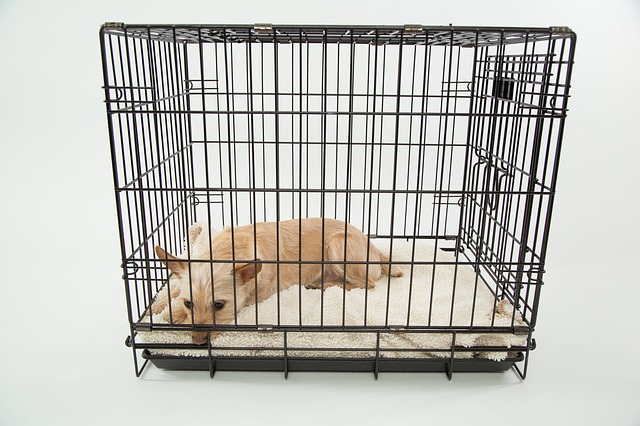
Pet cages have a time and place in the breeding process, but with Boxers you have to have the right size of cage and use them at the correct times. Pet cages should not be used during the mating and breeding process. Bitches who are pregnant should have very comfortable beds if you are going to crate them at night for safety. You should not expect the bitches to stay in crates 24/7.
When a bitch is about to give birth, create an open space for the birthing spot. Put down lots of old towels, old clothes you don’t intend to wash or wear again, etc. The dog may need to get up and walk around or get a drink of water. No food during this time, but have plenty of water available as giving birth will deplete the dog of fluids.
The male boxer, if present, should be removed to a separate area of the house and not be allowed in the room with the birthing mother. If the male is not present then you don’t have to concern yourself with this step.
After all the pups are born, schedule a vet check for the pups. If you used a stud dog and have an arrangement with the stud dog’s owner, invite that owner to the puppy’s first vet check. Usually dog breeders in partnership agree to a certain amount of money for fees and first pick of the litter, which is why the first vet check is the first important opportunity for the other owner to pick a puppy.
Containing Older Puppies and Preventing Litters of Weaker Animals With Defects
 The puppies will need to be near their mother for at least eight weeks. If you crate the whole family, watch for runts and weaker feeding pups. Boxers have been known to actually kill or eat runts and the weakest pups as a means of protecting the stronger pups, an instinct from eons ago. If you have runts or weak-feeding puppies, separate them from the bitch and bottle-feed these pups until they are bigger and stronger and no longer in danger.
The puppies will need to be near their mother for at least eight weeks. If you crate the whole family, watch for runts and weaker feeding pups. Boxers have been known to actually kill or eat runts and the weakest pups as a means of protecting the stronger pups, an instinct from eons ago. If you have runts or weak-feeding puppies, separate them from the bitch and bottle-feed these pups until they are bigger and stronger and no longer in danger.
As the pups grow, you may find you need a lot more room and need to crate them while you potty-train them. Each puppy should have its own large pet cage, which ends up being a lot of pet cages if the bitch has a lot of pups. Finally, any pups that had to be hand-raised should be fixed to avoid breeding them to other dogs. These pups can still be sold, but only after you have prevented them from producing offspring.
The BEST Advice? Learn From a Pro!
 While you are busy becoming an expert on these lovable dogs you will find that in every article about breeding Boxers (or any dog for that matter) is that you should spend time with a pro. Find someone who has been breeding Boxers for a decade or more and knows exactly what he/she is doing. Better yet, ask if he/she will mentor you in your endeavors to further the breed and mate your own dog to others. Most professional dog breeders are thrilled to share their knowledge, expertise, and experience with fellow lovers of a breed.
While you are busy becoming an expert on these lovable dogs you will find that in every article about breeding Boxers (or any dog for that matter) is that you should spend time with a pro. Find someone who has been breeding Boxers for a decade or more and knows exactly what he/she is doing. Better yet, ask if he/she will mentor you in your endeavors to further the breed and mate your own dog to others. Most professional dog breeders are thrilled to share their knowledge, expertise, and experience with fellow lovers of a breed.
If you can’t find a pro breeder for Boxers in your area, check with the AKC. They keep a long list of licensed and certified breeders and contact info for each of these breeders. In fact, that’s probably the best place to start, since you will have to apply for a breeding license and registration yourself.